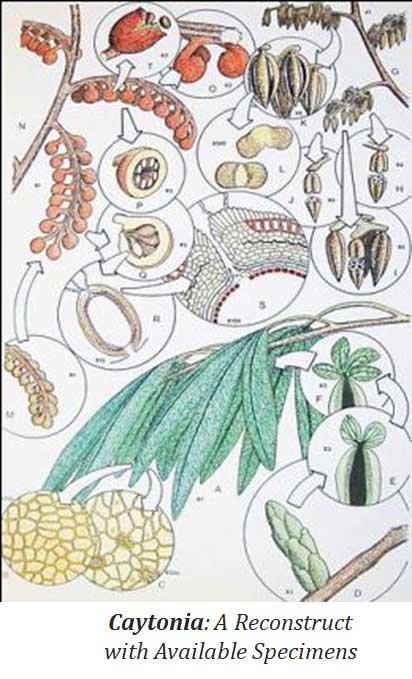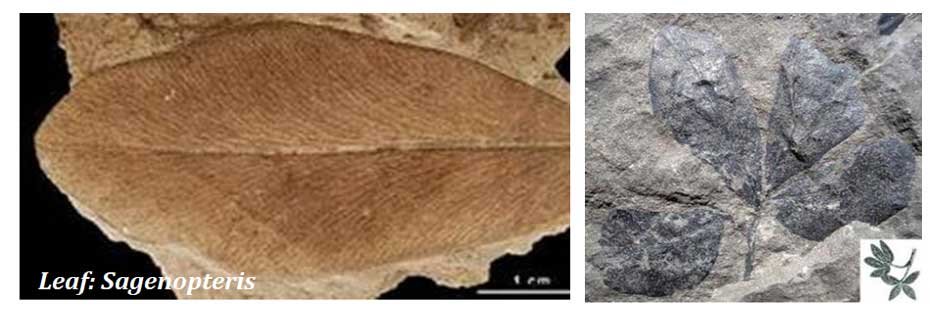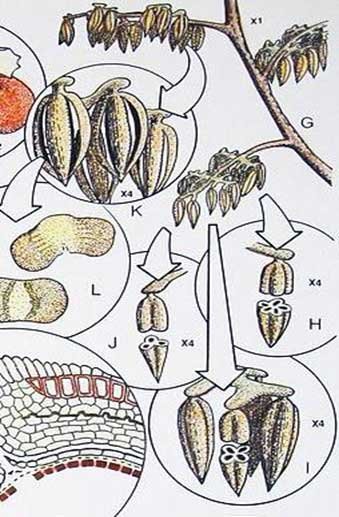Caytoniales are an extinct group of Mesozoic gymnosperms known primarily from fossil remains. They are characterized by fern-like compound leaves, enclosed ovules within fleshy cupules, and reproductive structures that show notable similarities to angiosperms. First described by Hamshaw Thomas in 1925, their fossils range from the Late Triassic/Early Jurassic to the Late Cretaceous. Although their exact phylogenetic position is uncertain, Caytoniales are often considered potential precursors to flowering plants due to their advanced reproductive features. This post discusses the general characteristics of Cyatoniales – Distribution, Phylogenetic significance, and Examples.
Overview of Caytoniales:
Ø Caytoniales represent a small group of fossil gymnosperms.
Ø The group was first described by Hamshaw Thomas in 1925.
Ø Fossil evidence spans from the late Triassic or early Jurassic to the late Cretaceous period.

Caytonia “Fruit”
Ø The name “Caytoniales” is derived from the genus Caytonia.
Ø Caytonia produces berry-like cupules (considered ‘fruit’) containing numerous small seeds.
Ø Initially, Caytoniales were classified as seed ferns due to their seed-bearing nature and fern-like foliage.
Ø They were once thought to be angiosperms because of their berry-like cupules (‘fruits’); however, this view is now considered obsolete.
Ø Some researchers continue to regard Caytoniales as potential ancestors of angiosperms.

Ø Caytoniales were branched, small trees or shrubs.
Ø They likely grew in waterlogged environments, as their fossils are often found alongside aquatic plants such as horsetails.
Ø No complete specimen of Caytoniales has been discovered to date.
Ø Notable examples include:
o Reconstructed whole plant: Caytonia
o Leaf: Sagenopteris
o Megasporophylls: Caytonia, Gristhorpia
o Microsporophyll: Caytonianthus
Characteristics of Leaves (Sagenopteris):
o Leaves are compound.
o The petiole is slender and bears 3 to 6 (commonly 4) terminal leaflets.
o Leaflets are arranged in a palmate pattern, typically in pairs.
o Each leaflet possesses a distinct midrib.
o Venation is reticulate, resembling that of Glossopteris.
o Leaf margins are smooth, with an acute apex.

Leaves of Caytoniales
o Leaflets detach through the formation of an abscission layer, similar to that in angiosperms.
o Leaflets exhibit dorsiventral symmetry.
o Both upper and lower epidermis are covered with a thick cuticle.
o Stomata are abundant on the lower epidermal surface.
o Stomatal development is haplocheilic.
o The mesophyll is differentiated into palisade tissue and transfusion tissue.
o Leaf surfaces are occasionally covered with hairs.
Microsporophyll: Caytonanthus
o Consists of a dorsiventral and pinnate rachis.
o The rachis bears pinnae on both sides.
o Each pinna branches irregularly.
o Ultimate branches terminate in synangia.
o Each terminal branch typically bears one synangium.

o Each sporangium usually contains four pollen sacs.
o Variations with 2, 3, or 5 pollen sacs have also been observed.
o Synangia are radially symmetrical.
o Dehiscence is longitudinal, separating the pollen sacs except at the base and apex.
o Pollen was produced in pollen sacs as tetrads (groups of four).
o Pollen grains were small and resembled those of pine trees in shape.
o Pollen grains were winged.
o Pollination was likely anemophilous (wind-pollinated).
Megasporophyll: Caytonia
o The megasporophyll is pinnate in structure.
o It consists of a dorsiventral rachis approximately 5 cm long with multiple outgrowths.
o These outgrowths are stalked and have swollen, berry-like tips.
o The outgrowths are referred to as “fruits.”
o Each ‘fruit’ has a stalk that broadens terminally into a pouch-like structure.
o The stalk bears a lip-like structure known as a ‘stigma.’

Female Fructifications in Caytonia
o The ‘fruits’ detach through an abscission layer, similar to leaves.
o Seeds are pendulous, oval, or flattened in shape.
o The surface of the ‘fruits’ is smooth.
o Caytoniales possessed fertile branches bearing seed-bearing, closed cupules.
o Ovules were enclosed within fleshy cupules covered by a tough outer cuticle.
o Each ovule featured an apical tube known as a micropylar canal.
o The number of micropylar canals corresponded to the number of ovules per ‘fruit.’
o The micropylar canal facilitated the entry of pollen into the pollen chamber.
o The outer layers of the cupules were fleshy and resembled fruits.
o Mature ovules bore a resemblance to blueberry fruits.
o The additional protection provided to seeds suggests that Caytoniales may have been precursors to angiosperms.
Phylogenetic Significance of Caytoniales
Ø The exact phylogenetic position of Caytoniales remains uncertain.
Ø Caytoniales have not been fully discovered or reconstructed.
Ø Limited information is available regarding the stem, and no data exists for the root system.
Ø Fossils are preserved only as compressions, preventing detailed anatomical or histological analysis.
Ø According to Harris, the synangia of Caytoniales resemble the stamens of angiosperms.
Ø Thomas (1925) proposed that the ‘fruits’ of Caytoniales represent an early stage in the evolution of angiosperm carpels.
Ø Harris (1951) noted that the cuticle pattern in Caytoniales is similar to that of angiosperms.
Affinities with Pteridospermales:
Ø Both groups possess pinnate leaves.
Ø Pollen-bearing structures (microsporophylls) are dorsiventral and pinnate in both groups.
Ø Megasporophylls are also dorsiventral and pinnate in two groups.
Ø Typical cones are absent in both Pteridospermales and Caytoniales, Similarly the reproductive structures are not organized into cones.
Ø Due to these similarities, most researchers believe that Caytoniales likely had a Pteridospermous ancestor or descendant.
Reference
Ø Bhatnagar, S.P. and Moitra, A., 1996. Gymnosperms. New Age International.
Ø Coulter, J.M. and Chamberlain, C.J., 1910. Morphology of Gymnosperms. University of Chicago Press.
Ø Vasishta, P.C., Sinha, A.K. and Kumar, A., 2016, Botany for Degree Students: Gymnosperms. S. Chand Pvt. Limited. Ram Nagar. New Delhi.
| You may also like NOTES in... | ||
|---|---|---|
| BOTANY | BIOCHEMISTRY | MOL. BIOLOGY |
| ZOOLOGY | MICROBIOLOGY | BIOSTATISTICS |
| ECOLOGY | IMMUNOLOGY | BIOTECHNOLOGY |
| GENETICS | EMBRYOLOGY | PHYSIOLOGY |
| EVOLUTION | BIOPHYSICS | BIOINFORMATICS |
I hope you found this article on Caytoniales-General Characteristics is informative and beneficial. Your feedback and comments would be greatly appreciated. Whether you have suggestions, questions, or thoughts to share, I would be delighted to hear from you. Please feel free to leave a comment below.
Regards: Admin, EasyBiologyClass

